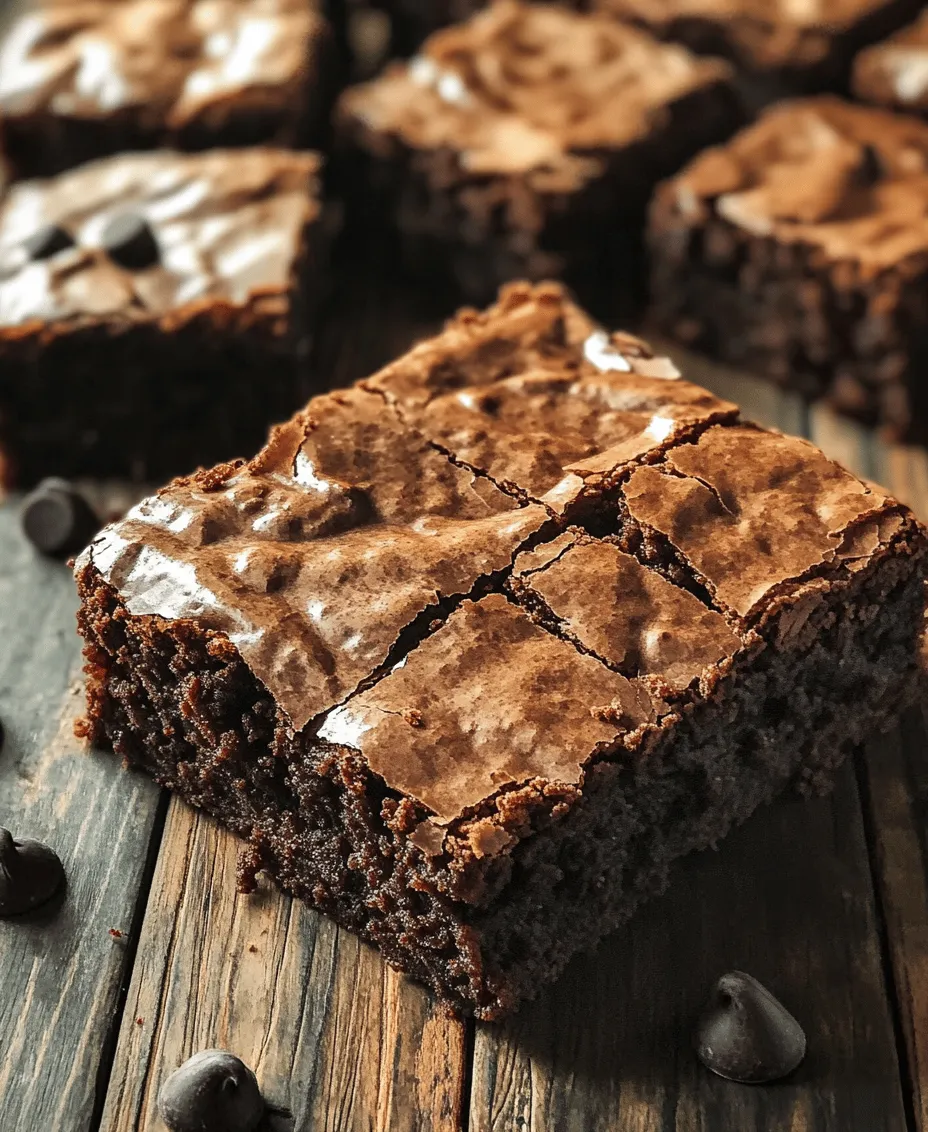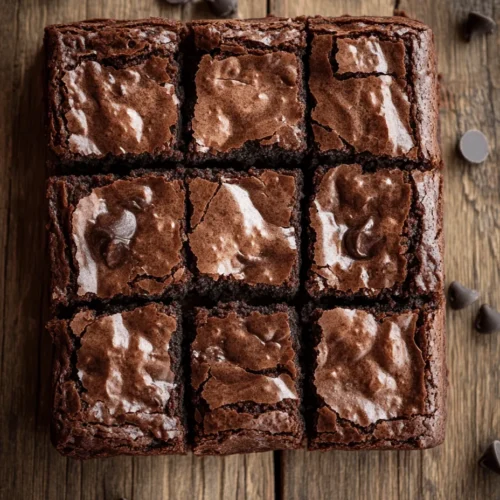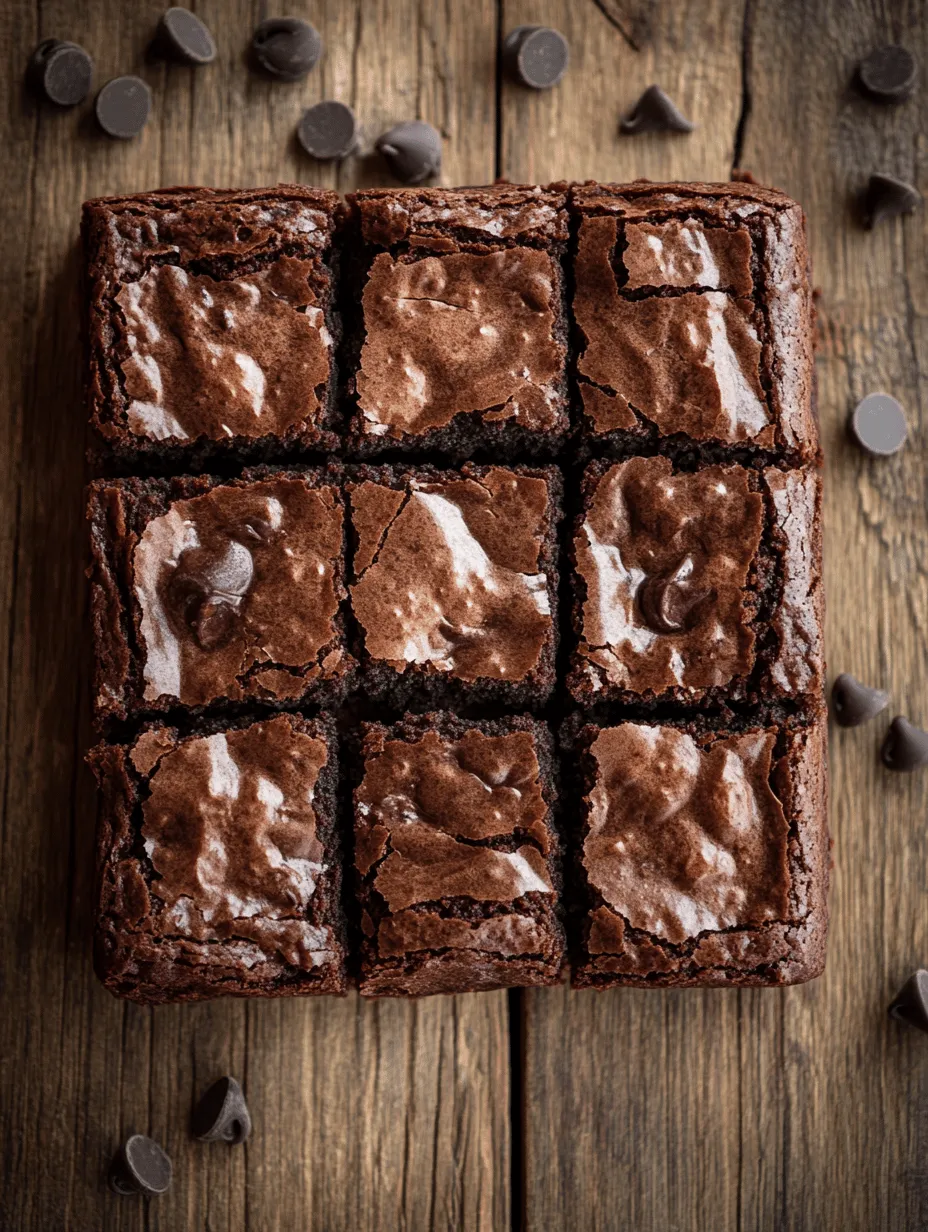Introduction
Brownies are more than just a dessert; they are a universal symbol of comfort and indulgence, cherished by dessert lovers across the globe. With their rich chocolate flavor and decadent texture, brownies have secured a special place in our hearts and on our dessert tables. Among the myriad of brownie variations, fudgy and chewy brownies stand out for their luxurious texture that melts in your mouth, leaving you craving just one more bite. The appeal of these brownies lies in their perfect harmony of sweetness and richness, offering a delightful experience that combines both the intense flavor of chocolate and a satisfying chewiness.
In this article, we will delve into the world of fudgy chewy brownies, guiding you through a recipe that balances these elements flawlessly. Whether you’re looking to impress guests at a gathering or simply want to treat yourself to an afternoon indulgence, this recipe is sure to become a staple in your baking repertoire. Let’s explore the foundational ingredients that make these brownies so irresistible and set the stage for crafting your own delicious batch.
Understanding the Ingredients
The magic of fudgy chewy brownies begins with understanding the role of each ingredient. Each component contributes to the overall flavor, texture, and enjoyment of the final product. Here’s a closer look at what makes these brownies so special.
Unsalted Butter: The Foundation of Flavor
At the heart of every great brownie recipe is unsalted butter, the unsung hero that brings depth and richness to the dessert. The fat content in butter is crucial for achieving that fudgy texture that brownie enthusiasts crave. When you melt unsalted butter and mix it with sugar, it creates a smooth, silky base that helps to bind the ingredients together while imparting a rich flavor.
Choosing unsalted butter, as opposed to salted, allows you to control the sweetness of your brownies more effectively. This is particularly important in a dessert where balancing the sweetness is key to achieving a well-rounded flavor profile. The absence of salt lets the chocolate flavor shine, ensuring that the brownies are not overly salty but still have a depth of flavor.
Granulated Sugar: Sweetness and Structure
Granulated sugar plays a dual role in brownie-making. Firstly, it contributes to the sweetness that brownies are known for, but it also plays a significant part in the texture. When sugar is creamed with butter, it helps to incorporate air into the batter, leading to a lighter texture. However, for fudgy brownies, we want to strike the right balance.
While granulated sugar is a classic choice, you might consider experimenting with brown sugar as well. Brown sugar contains molasses, which adds moisture and enhances chewiness, resulting in an even fudgier brownie. Using a combination of both granulated and brown sugar can yield a delightful complexity in flavor and texture.
Eggs: Binding Agents for Richness
Eggs are essential in brownie recipes, acting as binding agents that provide structure and richness. The proteins in eggs coagulate during baking, helping the brownies hold their shape. Additionally, eggs contribute to the moistness, creating that signature fudgy bite that makes brownies so appealing.
The number of eggs used can also affect the final result. Using more eggs typically results in a cakey brownie, while fewer eggs enhance the fudgy texture. For our fudgy chewy brownies, we will use the perfect amount to ensure a rich, gooey center without losing that satisfying chew.
Vanilla Extract: Enhancing the Flavor Profile
Vanilla extract is often an overlooked ingredient, but it plays a vital role in elevating the overall flavor of brownies. The warm, aromatic notes of vanilla complement the rich chocolate, enhancing its depth and complexity. For the best results, opt for high-quality vanilla extract, as it can significantly impact the flavor of your brownies.
A splash of vanilla extract not only adds flavor but also helps to round out the sweetness, ensuring that the brownies taste well-balanced.
Flour and Cocoa Powder: The Dry Essentials
The dry ingredients in our brownie recipe, namely all-purpose flour and cocoa powder, are crucial for achieving the desired structure and chocolate flavor. All-purpose flour provides the necessary gluten content, which gives the brownies their chewy texture. However, too much flour can lead to a dry result, so precision is vital.
Cocoa powder is where the magic happens in terms of flavor. It imparts that rich chocolate taste that brownies are renowned for. When selecting cocoa powder, consider using a high-quality Dutch-processed cocoa for a deeper, more intense chocolate flavor, or stick with natural cocoa for a brighter taste. The choice of cocoa powder can subtly alter the flavor profile of your brownies, so choose according to your preference.
Salt and Baking Powder: Balancing Act
Salt is often seen as a simple seasoning, but in baking, it serves a more complex purpose. A pinch of salt enhances the flavors of the brownies, making the chocolate taste even richer. It helps to balance the sweetness, ensuring that the brownies do not taste overly sugary.
Baking powder is another critical ingredient, albeit used in smaller amounts. While some brownie recipes may omit it entirely, a small amount can help provide a slight lift, creating a tender texture without compromising the fudgy quality. This is particularly important if you prefer your brownies to have just a hint of rise without losing that coveted dense center.
Optional Add-ins: Customizing Your Brownies
One of the best aspects of baking brownies is the flexibility to customize them to your taste. Adding chocolate chips can amplify the fudginess, providing pockets of melty chocolate that make each bite even more indulgent. Dark chocolate chips, semi-sweet, or even white chocolate can all add unique flavors and textures.
Nuts are another popular addition, contributing a delightful crunch that contrasts beautifully with the soft brownie. Whether you prefer walnuts, pecans, or almonds, adding nuts can enrich the overall experience and introduce a different flavor component. The key is to find the right balance of add-ins to enhance, rather than overwhelm, the brownie’s inherent richness.
Step-by-Step Instructions
Preparation: Setting the Stage
Now that we understand the essential ingredients that contribute to the perfect fudgy chewy brownie, it’s time to prepare for baking. The first step in creating these delectable treats is gathering all necessary ingredients and tools.
Ingredients:
– 1 cup unsalted butter
– 2 cups granulated sugar
– 4 large eggs
– 1 tablespoon vanilla extract
– 1 cup all-purpose flour
– 1 cup unsweetened cocoa powder
– 1 teaspoon baking powder
– 1/2 teaspoon salt
– Optional: 1 cup chocolate chips or nuts of your choice
Tools:
– 9×13-inch baking pan
– Mixing bowls
– Whisk or electric mixer
– Rubber spatula
– Measuring cups and spoons
– Parchment paper (optional for easier removal)
Once you have everything ready, preheat your oven to 350°F (175°C). This ensures that the brownies bake evenly and helps achieve that perfect texture.
Next, prepare your baking pan by greasing it lightly with butter or lining it with parchment paper. Lining the pan with parchment allows for easy removal of the brownies once they have cooled, making it easier to cut them into squares without sticking.
With the stage set, you’re ready to embark on the delightful journey of creating your fudgy chewy brownies. The following sections will provide detailed, step-by-step instructions to guide you through the mixing, baking, and cooling process.
Stay tuned as we dive deeper into the art of brownie-making, ensuring that you achieve the perfect balance of sweetness and richness in every bite.

Preheating the oven and greasing the baking pan are foundational steps that should never be overlooked when baking fudgy, chewy brownies. Preheating ensures that your brownies start cooking at the right temperature, creating that delicious crust on the top while keeping the inside moist and fudgy. Aim to preheat your oven to 350°F (175°C) before you start mixing your ingredients. This way, when your brownie batter is ready, the oven is hot and ready to work its magic.
Equally important is greasing the baking pan. Use a generous amount of butter or non-stick spray on the bottom and sides of your pan. This prevents the brownies from sticking, allowing for easy removal once they are baked. For added assurance, you can also line the pan with parchment paper, leaving some overhang on the sides to create easy handles for lifting out the brownies after they’ve cooled.
Tips for Measuring Ingredients Accurately
When it comes to baking, precision is key. Accurate measurements can mean the difference between a batch of perfect brownies and a disappointing outcome. Here are some tips to help you measure your ingredients accurately:
1. Use the Right Tools: Invest in a set of measuring cups and spoons for dry ingredients and liquid measuring cups for wet ingredients. A kitchen scale is also a great tool for weighing ingredients, ensuring accuracy.
2. Fluff Up Flour: Before measuring flour, use a spoon to fluff it up in the container. This adds air, making it less dense. Use a spoon to scoop the flour into your measuring cup and level it off with a knife for accuracy.
3. Liquid Measurements: For liquids, make sure to check the measurement at eye level. This avoids the common mistake of over-pouring.
4. Brown Sugar: When measuring brown sugar, press it firmly into the measuring cup to eliminate any air pockets.
Melting the Butter and Combining Ingredients
Now that your oven is preheating and your ingredients are measured accurately, it’s time to melt the butter. Melt 1 cup (2 sticks) of unsalted butter in a medium saucepan over low heat. Stir frequently to ensure the butter melts evenly without browning. Once melted, remove the saucepan from heat and let it cool for a few minutes.
Next, in a large mixing bowl, combine the melted butter with 2 cups of granulated sugar. Whisk the mixture until it’s smooth and glossy. This step is crucial as it helps to dissolve the sugar, resulting in a fudgier texture. Afterward, add in 4 large eggs, one at a time, whisking well after each addition. Incorporate 2 teaspoons of vanilla extract, mixing until everything is well combined.
The mixing technique here is vital for achieving the right texture. Overmixing can lead to cakey brownies, while undermixing may result in uneven distribution of ingredients. Aim for a smooth batter that is well combined but still retains a bit of thickness.
Combining Dry Ingredients: The Art of Sifting
Now it’s time to prepare the dry ingredients. In a separate bowl, combine 1 cup of all-purpose flour, 3/4 cup of unsweetened cocoa powder, 1 teaspoon of baking powder, and 1/2 teaspoon of salt. Sifting these dry ingredients together is important for several reasons:
1. Aeration: Sifting helps to aerate the flour and cocoa powder, which can lead to a lighter brownie texture.
2. Clump Removal: Cocoa powder can clump together, and sifting ensures that these clumps are broken up, resulting in a smoother batter.
3. Even Distribution: Sifting also helps to evenly distribute the baking powder and salt, ensuring consistent flavor throughout the brownies.
Once sifted, gently fold the dry ingredients into the wet ingredients using a spatula or wooden spoon. Be careful to avoid overmixing; mix just until the dry ingredients are incorporated. A few small lumps are okay—overmixing will create a tougher brownie.
Incorporating Optional Ingredients: Personal Touch
One of the best parts of making brownies is the opportunity to customize them. After combining the wet and dry ingredients, consider folding in 1 cup of chocolate chips or chopped nuts like walnuts or pecans. These additions elevate the flavor and texture of your brownies, adding little bursts of chocolate or a satisfying crunch.
Chocolate chips will melt slightly, creating gooey pockets of chocolate, while nuts will provide a lovely contrast to the fudgy base. Feel free to experiment with different types of chocolate chips, such as dark, milk, or even white chocolate, to create a blend that suits your taste.
Baking and Cooling: Key to the Perfect Brownie
Transfer the brownie batter to your prepared baking pan and spread it evenly. Bake in the preheated oven for 20 to 25 minutes. The baking time may vary depending on your oven and the size of your baking pan, so keep an eye on them. To test for doneness, insert a toothpick into the center; it should come out with a few moist crumbs, not wet batter. Remember, the brownies will continue to cook slightly as they cool, so it’s better to underbake them than overbake.
After baking, remove the brownies from the oven and allow them to cool in the pan for about 10-15 minutes. Then, carefully lift them out using the parchment paper if you used it, or transfer them to a wire rack. Allow the brownies to cool completely before cutting them into squares. Cooling is crucial for achieving that perfect fudgy texture—cutting them too soon can result in a messy brownie situation.
Serving Suggestions
When it comes to serving your fudgy, chewy brownies, presentation can make all the difference. Here are some creative ideas and pairing suggestions:
1. Plating: Serve brownies on a decorative plate or cutting board. Dust with powdered sugar for an elegant touch, or drizzle with melted chocolate or caramel for an added flair.
2. Garnishes: Fresh mint leaves or a sprinkle of sea salt can enhance the visual appeal. Consider adding a scoop of vanilla ice cream on the side or a dollop of whipped cream for a classic combination.
3. Pairing Suggestions: Brownies pair wonderfully with a glass of cold milk, coffee, or a rich dessert wine. They also make a delightful addition to a dessert table at gatherings, complementing other treats.
Storing and Reheating Brownies
To maintain the freshness of your brownies, store them in an airtight container at room temperature for up to 3-4 days. If you want to keep them longer, consider refrigerating them, which can extend their shelf life by about a week. Just be sure to allow them to come to room temperature before serving, as they may harden in the fridge.
If you have any leftovers—or if you simply want to enjoy them warm again—reheating is straightforward. Place a brownie on a microwave-safe plate and heat it for about 10-15 seconds. This will soften the brownie without compromising its texture. For an even more indulgent experience, top the warmed brownie with a scoop of ice cream.
Nutritional Information
Understanding the nutritional content of your brownies can help you enjoy them mindfully. Each serving of these fudgy brownies contains approximately:
– Calories: 200-250 calories per brownie (depending on size and added ingredients)
– Fat: 10-15g (mostly from butter and chocolate)
– Carbohydrates: 27-30g
– Protein: 2-3g
Portion sizes can vary, but a standard serving is typically one square brownie. While brownies are undoubtedly a treat, they can certainly be enjoyed in moderation as part of a balanced diet.
Conclusion
Baking fudgy, chewy brownies is not just about following a recipe; it’s about the joy of creating something delicious that can bring people together. Whether you enjoy them plain or dressed up with ice cream and toppings, these brownies are sure to delight. Don’t hesitate to experiment with the recipe—try different mix-ins, adjust the sweetness, or even swap ingredients based on what you have on hand.
Homemade brownies have a special place in our hearts and kitchens, perfect for celebrations, gatherings, or simply as a comforting treat at the end of a long day. So preheat that oven, gather your ingredients, and indulge in the delightful process of baking these irresistible fudgy brownies.


